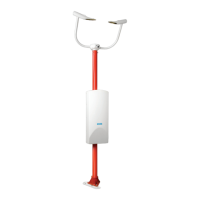USER'S GUIDE ____________________________________________________________________
120 __________________________________________________________________ M211187EN-C
Signal Monitoring
The saturation of the receiver unit is monitored by measuring the DC
signal level of the photodiode amplifier. In case direct or reflected
sunlight enters the receiver optics, the DC level of measured electrical
signal may increase to a point where it will have an effect on the
visibility measurement. When the DC signal saturation is too high for
reliable measurement, the visibility data is set as missing (/////) and a
RECEIVER SIGNAL SATURATED alarm is generated.
The scatter signal saturation is monitored by the visibility measurement
itself. If the maximum signal value is reached, the measurement is
saturated and no reliable measurements can be made. In this case the
visibility data is set as missing (/////) and an alarm SCATTER SIGNAL
SATURATED is generated. The most probable reason for the scatter
signal saturation is an obstacle in the measurement volume that causes
excessive signal reflection to the receiver.
The offset error of the receiver unit in FS11 is monitored regularly. CPU
disables the transmitter unit and performs the normal scatter
measurement procedure without the transmitted light pulses. In case the
high offset signal level is too high, a SIGNAL OFFSET DRIFTED alarm
message is given and the visibility data is set as missing (/////).
The most probable reason for increased signal offset is optical
interference from another visibility sensor in the vicinity or other
interference problem at a frequency of approximately 2.2 kHz.
Transmitter Intensity Stability
The transmitter intensity is kept stable with a feedback loop that uses a
PIN photodiode for light power output monitoring. The drive current of
the LED is monitored to detect an increase in the current. The only
natural causes of change are dirt in the light path and aging of the LED.
When more power is needed, the drive current increases. When the drive
current has increased above a level which makes the LED deteriorate
faster than before, but still allows reliable measurements (225 mA), a
warning LED AGED is generated for a weak LED. An alarm LED
FAILURE is generated when the drive current has increased above a
level that does not allow reliable measurements (325 mA, visibility data
is set to /////).

